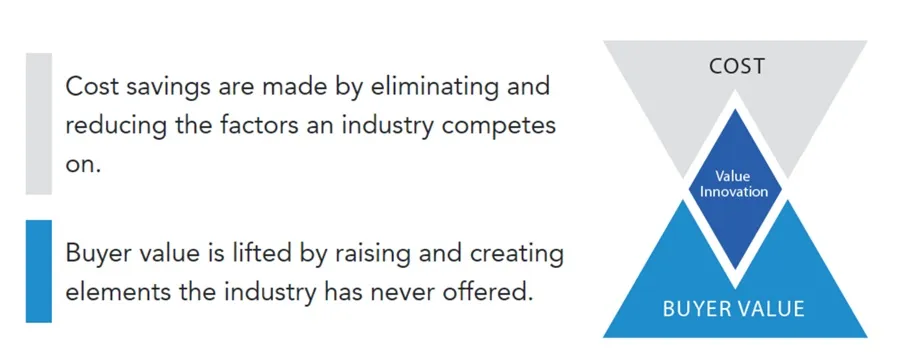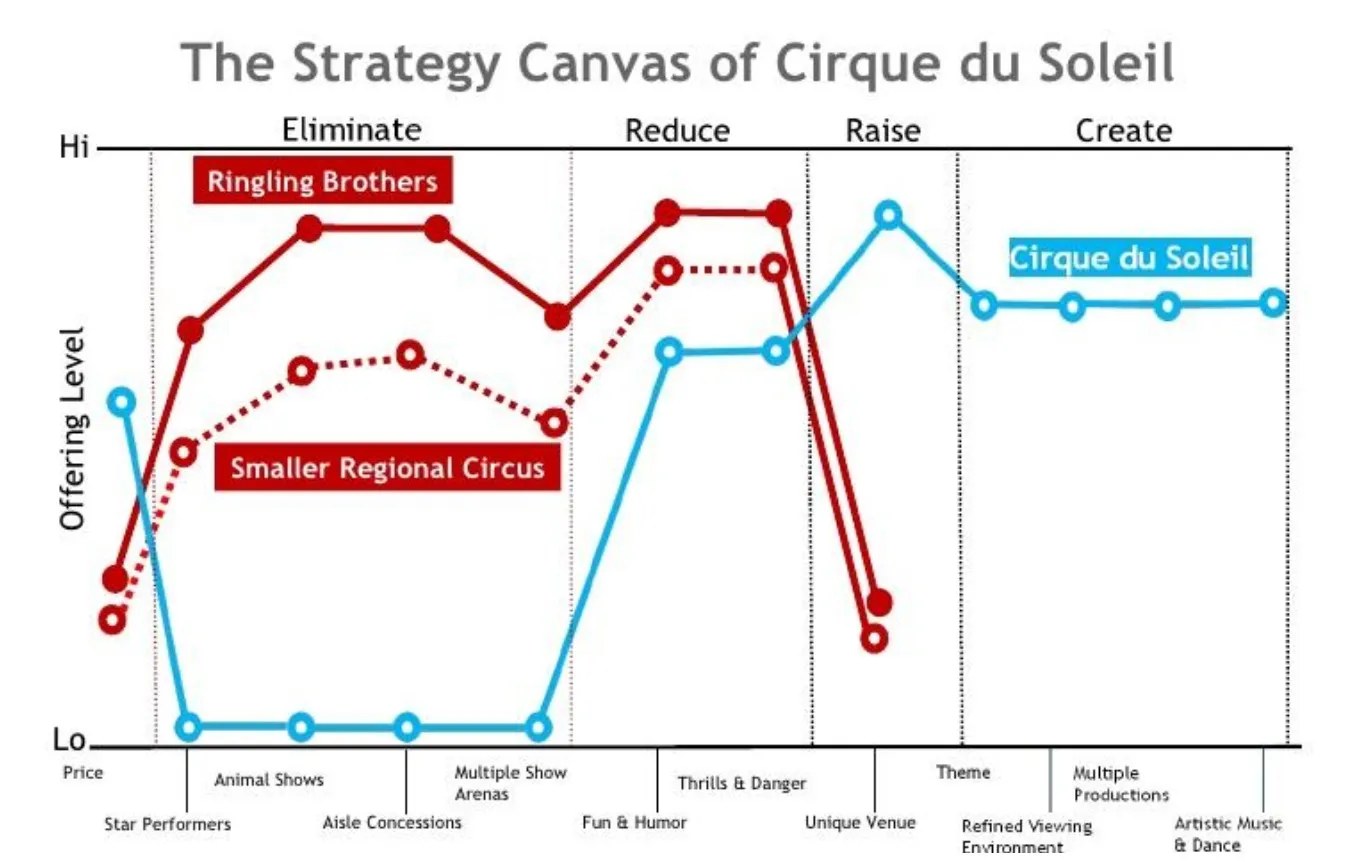Most organizations aim to expand their current customer bases by gaining more market share from their competitors. Companies that compete head-to-head focus on matching or beating their rivals by offering slightly improved versions of their products. Branding, quality and the cost of the product are often the main differentiators.
Many organizations face challenges when competing in a highly saturated market. Because the market has a certain size and a limited growth potential, companies that are able to be innovative and provide the most value for the customer, are most likely to gain bigger market shares. Usually, the big industry leaders dominate the market, and the small followers are left scraping for whatever remains.
When people believe that industry conditions are given, strategies and business models become too similar, and the competition will be based on incremental improvements. The issue with this type of conventional approach is that it’s often a slow and stagnant way to grow a business.
When differentiation in an existing market isn’t enough, industries need to be shaped to unlock new market spaces. To swim clear of the bloody competition towards more profitable growth, one needs to be able to create new demand while breaking the traditional value-cost trade-off.
Introducing The Blue Ocean Strategy
The Blue Ocean Strategy is a framework first introduced by W. Chan Kim and Renee Mauborgne in a book bearing the same name. Blue Ocean is based on more than a decade-long study including 150 strategic moves spanning more than 30 industries over 100 years.
It describes the differences that separate winners from the mere survivors and those adrift in the bloody red ocean. Rather than fighting over existing demand, profitable growth is achieved by unlocking a new market space for yourself – a blue, uncontested ocean.
How to secure that Blue Ocean?
The Blue Ocean Strategy introduces a number of tools and frameworks that can be used to create blue oceans of new market space. One of the most significant aspects for creating that new demand is value innovation.
Value Innovation
Often, companies focus either on differentiation or driving costs down. It is, however, easier to gain competitive advantage when both ways to win are pursued.
Value innovation is one of the frameworks that can be used to create product or services with no direct competitors. It rejects the fundamental principles of conventional strategy and focuses on creating value in a new uncontested market space while keeping acceptable profit margin.
It’s a simultaneous pursuit of differentiation and low cost that appeals to a new customer segment. In other words, the buyer value will be raised while the costs will be decreased.

Source: Blue Ocean Strategy
The idea behind value innovation isn’t coming up with a completely new idea, as there’s a chance someone has already thought of it before you. Instead, you should look to create a new market space for yourself and offer different kind of value that the market hasn’t seen before.
It should be mentioned that blue ocean space isn’t something that already exists and is just waiting to be found but needs to be created. Value innovation is possible to achieve by mirroring your value curve to the value curve of the present industry and what it takes for granted.
Value innovation looks at the business strategy from four perspectives to create a new value curve:
- Eliminate – What will be eliminated completely?
- Raise – What elements should be raised in the present industry?
- Reduce – What elements should be reduced?
- Create – What new industry factors can generate value?
Strategy Canvas
To avoid falling into the trap of competing with the same value factors as most of the competitors, and to map your strategic decisions, you can use the Blue Ocean Strategy Canvas. It allows you to capture the current state in the known market space, to see the factors an industry competes on and to visualize how a blue ocean strategy breaks away from the existing red ocean.
A classic example of a successful execution of The Blue Ocean Strategy is Cirque du Soleil, which managed to challenge the conventions of the declining circus industry by reinventing the circus and making competition irrelevant.

Source: Sage Growth Partners
Cirque du Soleil was able to innovate and shift the main buyer group from children (end-users of the traditional circus) to adults (purchasers of the traditional circus), drawing upon the distinctive strengths of other alternative industries, such as Broadway shows, the theatre, and the opera. This shift allowed them to offer a totally new set of utilities to more mature and higher spending customers.
Instead of looking for alternative industries, it succeeded in shaping the current industry and created a unique business that helped them achieve highly profitable growth.
To conclude
Swimming in a red, highly competitive ocean and simply offering a slightly better solution with a slightly more competitive price, isn’t often a sustainable way to grow. It’s not uncommon for business owners to try to run ever faster to stay ahead of the competition, or to simply defend their current market position.
When competition is fierce and exploiting existing demand is difficult, new demand needs to be created. Value innovation helps make the competition irrelevant through simultaneous product differentiation and cost leadership.
It is a good technique to use if you want to see the current state of the industry and what it competes on but has also been criticized for not paying adequate stress on conducting market viability tests.
To see if value innovation could be applied to your industry, start by drawing you own value curve and see how it compares to the industry standards.
If you’d like to find out how innoway can help your organisation apply Value Innovation, contact us here.
Julia Myllylä represents Viima, the best way to collect and develop ideas. Viima’s innovation management software is already loved by thousands of organizations all the way to the Global Fortune 500. She’s passionate about helping leaders drive innovation in their organizations and frequently writes on the topic, usually in Viima’s blog.



